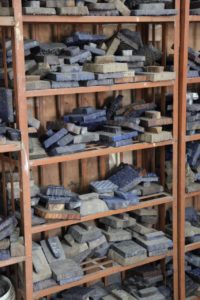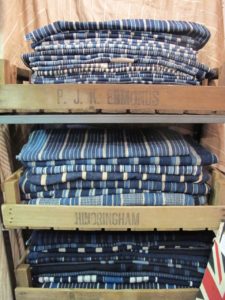Image from Calluna : Cushions – Heather Luke
Indigofera tinctoria, or true Indigo, is a plant from which the dye and deep blue colour Indigo is derived. Indigo dye is known all over the world and can be sourced from a number of other plants and species. In the natural range of dyes, indigo is high on the colour-fast list, ageing and fading beautifully; denim jeans are indigo dyed.
The Japanese are ancient users of Indigo and process their leaves in quite a different manner to the Indians–initially using a dry fermentation process.
Indian textile dyers and printers have been using indigo for seven thousand years in natural indigo fermentation, which requires far less water than the newer processes do, and no fixing agents. The indigo dye liquid is held in 10’ deep terracotta pots buried in the earth, where it remains for one year, during which time it is stirred at frequent intervals.
As we know form our denim jeans indigo goes with everything.
Sewa in Lucknow work chikankari – embroidery into cotton, and indigo is sued to set out the designs.
Image from Calluna : Cushions – Heather Luke
Indigo is a vital source of colour across the globe but perhaps most specifically for the hand printed and weaves, the vegetal dyes of both India and Africa. Here is a selection of Adire.
The end piece of an indigo dyed hemp sheet that we used to make simple fold over cushions.
Image from Calluna : Cushions – Heather Luke
www.adireafricatextiles.com




